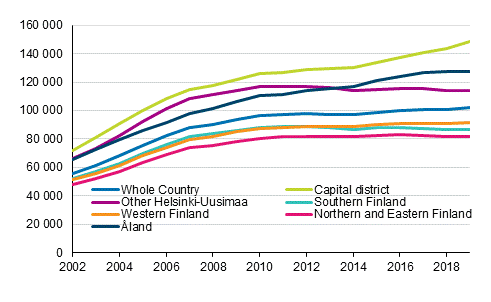Published: 18 June 2020
Largest housing loans in Greater Helsinki
Statistics Finland’s statistics on indebtedness show that the average size of a housing loan per household-dwelling unit with a housing loan was EUR 102,240 in 2019. The average housing loan grew by 1.2 per cent year-on-year in real terms. Household-dwelling units in Greater Helsinki had the largest housing loans, EUR 148,500, on average. Housing loans also grew most in Greater Helsinki, by 3.4 per cent from the year before. Elsewhere in Finland changes in average housing loans were small. Housing loans were lowest among those with housing loans in Northern and Eastern Finland, EUR 81,700, on average.
Average housing loans of household-dwelling units with housing loans in 2002 to 2019, EUR in 2019 money

In 2019, there were 1.45 million indebted household-dwelling units in Finland. Thus 53 per cent or slightly over one-half of household-dwelling units were indebted. Their total debt amounted to EUR 126.9 billion, which in real terms is two per cent more than in the previous year. Of household-dwelling units’ debts, EUR 89.6 billion were housing loans, EUR 8.9 billion were loans taken out for business purposes, and EUR 28.4 billion were other debts. Other debts include debts taken out for consumption and larger purchases and study loans. Loans charged on business activities or a source of income grew most, by 7.2 per cent, from the previous year. Other debts of household-dwelling units increased by 4.2 per cent and housing loans by one per cent from the year before.
One-quarter of indebted household-dwelling units had debts of at most EUR 10,000 and one-half at most EUR 50,000 in 2019. There were a total of 166,700 household-dwelling units with more than EUR 200,000 in debt, which represents 6.1 per cent of all household-dwelling units and 11.5 per cent of indebted household-dwelling units. The number of household-dwelling units this much in debt grew by four per cent from the previous year. A total of 60,300 household-dwelling units had debts of at least EUR 300,000, being 2.2 per cent of all and 4.2 per cent of all indebted household-dwelling units. The number of these debts increased by seven per cent from the previous year.
One-third of all household-dwelling units, or 875,900, had housing loans. There were roughly the same number of household-dwelling units with housing loans as in 2018. Household-dwelling units with the reference person aged 35 to 44 had most often a housing loan. Sixty per cent of household-dwelling units of that age had housing loans. Housing loans were less common among the youngest and oldest household-dwelling units: seven per cent of household-dwelling units of persons aged under 25 and 11 per cent of those aged at least 65 had housing loans in 2019.
Housing loans were common for household-dwelling units that had children. Seventy-one per cent of household-dwelling units with two adults and children had housing loans. Their average housing loan was EUR 138,700 in 2019. The average housing loan of single-supporter families with housing loans was EUR 92,140. Childless household-dwelling units of two adults with housing loans had, on average, EUR 89,300 in housing loans and one-person household-dwelling units EUR 69,520.
In 2019, household-dwelling units paid EUR 1.6 billion in interests, which was in real terms two per cent less than in the year before. Of them, EUR 842 million were interest expenses from housing loans, which was five per cent less than in the year before. Households paid an average of EUR 1,130 in interests per indebted household-dwelling unit, while the corresponding figure in 2018 was EUR 1,170. On average, household-dwelling units with housing loans paid EUR 960 in interests on their housing loans. Of indebted household-dwelling units, 61 per cent, or 878,200, paid in a year at most EUR 1,000 in interests and nearly three per cent, or 37,600 household-dwelling units over EUR 5,000.
Source: Indebtedness 2019, Statistics Finland
Inquiries: Auli Hämäläinen 029 551 3615, toimeentulo@stat.fi
Director in charge: Jari Tarkoma
Publication in pdf-format (171.7 kB)
- Tables
-
Tables in databases
Pick the data you need into tables, view the data as graphs, or download the data for your use.
Updated 18.6.2020
Official Statistics of Finland (OSF):
Indebtedness [e-publication].
ISSN=2489-3285. 2019. Helsinki: Statistics Finland [referred: 19.4.2025].
Access method: http://stat.fi/til/velk/2019/velk_2019_2020-06-18_tie_001_en.html

